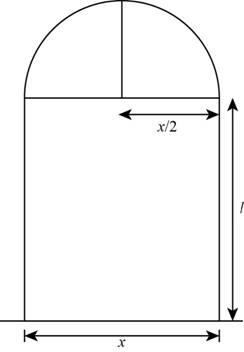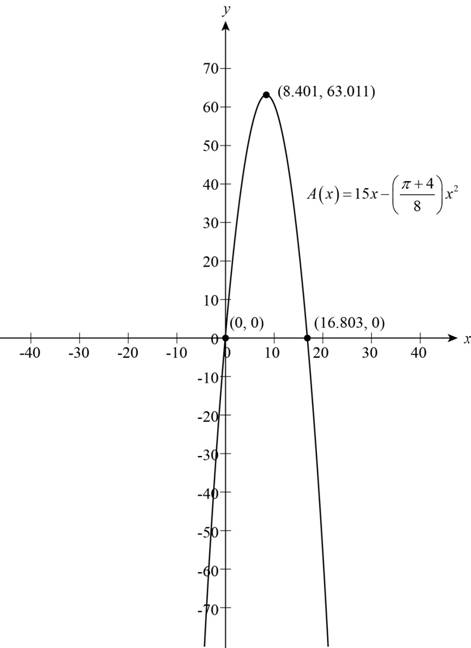
Concept explainers
Light from a Window A Norman window has the shape of a rectangle surmounted by a semicircle, as shown in the figure to the left. A Norman window with perimeter 30 ft is to be constructed.
- (a) Find a function that models the area of the window.
- (b) Find the dimensions of the window that admits the greatest amount of light.
(a)
To find: The function that models the area of the window.
Answer to Problem 25P
The function that models the area of the window is
Explanation of Solution
Given:
A Norman window is in the shape of the rectangle with perimeter

Figure (1)
Formula used:
The area of the rectangle is,
Perimeter of the rectangle is,
The area of the semi circle is,
Perimeter of the semi circle is,
Calculation:
Let the length in the Norman window is l units and the radius of the semicircle is r units.
The Norman window with the radius of the semicircle and the length of the rectangle is shown below.

Figure (2)
The radius of the semicircle is,
The perimeter of the Norman window is,
Substitute
Further solve the equation,
The length of the window is
The area of the Norman window is,
Substitute
Further solve the above equation,
Thus, the function that models the area of the window is
(b)
To find: The dimension of the window that admits the greatest light.
Answer to Problem 25P
The width of the Norman window is
Explanation of Solution
From the part(a), the function that models the area of the window is
To find the dimension that admits the greatest amount of light, it needs to draw the graph of the function
The function contains the variable x is the breadth of the rectangular portion of the window.
The local maximum value of the function is the maximum finite value where the value of the function at the any number is greater than to the original function.
The condition for local minimum is,
The graph of the function is shown below,

Figure (3)
From the graph of the function shown as Figure (3) the greatest peak of the graph at the point
Then the maximum light admit from the Norman window is
Substitute 8.4 for x in the length
The length of the window is
Thus, the width of the Norman window is
Chapter 2 Solutions
Precalculus: Mathematics for Calculus - 6th Edition
- Ministry of Higher Education & Scientific Research Babylon University College of Engineering - Al musayab Automobile Department Subject :Engineering Analysis Time: 2 hour Date:27-11-2022 کورس اول تحليلات تعمیر ) 1st month exam / 1st semester (2022-2023)/11/27 Note: Answer all questions,all questions have same degree. Q1/: Find the following for three only. 1- 4s C-1 (+2-3)2 (219) 3.0 (6+1)) (+3+5) (82+28-3),2- ,3- 2-1 4- Q2/:Determine the Laplace transform of the function t sint. Q3/: Find the Laplace transform of 1, 0≤t<2, -2t+1, 2≤t<3, f(t) = 3t, t-1, 3≤t 5, t≥ 5 Q4: Find the Fourier series corresponding to the function 0 -5arrow_forwardMinistry of Higher Education & Scientific Research Babylon University College of Engineering - Al musayab Subject :Engineering Analysis Time: 80 min Date:11-12-2022 Automobile Department 2nd month exam / 1" semester (2022-2023) Note: Answer all questions,all questions have same degree. کورس اول شعر 3 Q1/: Use a Power series to solve the differential equation: y" - xy = 0 Q2/:Evaluate using Cauchy's residue theorem, sinnz²+cosz² dz, where C is z = 3 (z-1)(z-2) Q3/:Evaluate dz (z²+4)2 Where C is the circle /z-i/-2,using Cauchy's residue theorem. Examiner: Dr. Wisam N. Hassanarrow_forwardMinistry of Higher Education & Scientific Research Babylon University College of Engineering - Al musayab Subject :Engineering Analysis Time: 80 min Date:11-12-2022 Automobile Department 2nd month exam / 1" semester (2022-2023) Note: Answer all questions,all questions have same degree. کورس اول شعر 3 Q1/: Use a Power series to solve the differential equation: y" - xy = 0 Q2/:Evaluate using Cauchy's residue theorem, sinnz²+cosz² dz, where C is z = 3 (z-1)(z-2) Q3/:Evaluate dz (z²+4)2 Where C is the circle /z-i/-2,using Cauchy's residue theorem. Examiner: Dr. Wisam N. Hassanarrow_forwardWhich degenerate conic is formed when a double cone is sliced through the apex by a plane parallel to the slant edge of the cone?arrow_forward1/ Solve the following: 1 x + X + cos(3X) -75 -1 2 2 (5+1) e 5² + 5 + 1 3 L -1 1 5² (5²+1) 1 5(5-5)arrow_forwardI need expert handwritten solution.to this integralarrow_forwardExample: If ƒ (x + 2π) = ƒ (x), find the Fourier expansion f(x) = eax in the interval [−π,π]arrow_forwardExample: If ƒ (x + 2π) = ƒ (x), find the Fourier expansion f(x) = eax in the interval [−π,π]arrow_forwardPlease can you give detailed steps on how the solutions change from complex form to real form. Thanks.arrow_forwardarrow_back_iosSEE MORE QUESTIONSarrow_forward_ios
 Calculus: Early TranscendentalsCalculusISBN:9781285741550Author:James StewartPublisher:Cengage Learning
Calculus: Early TranscendentalsCalculusISBN:9781285741550Author:James StewartPublisher:Cengage Learning Thomas' Calculus (14th Edition)CalculusISBN:9780134438986Author:Joel R. Hass, Christopher E. Heil, Maurice D. WeirPublisher:PEARSON
Thomas' Calculus (14th Edition)CalculusISBN:9780134438986Author:Joel R. Hass, Christopher E. Heil, Maurice D. WeirPublisher:PEARSON Calculus: Early Transcendentals (3rd Edition)CalculusISBN:9780134763644Author:William L. Briggs, Lyle Cochran, Bernard Gillett, Eric SchulzPublisher:PEARSON
Calculus: Early Transcendentals (3rd Edition)CalculusISBN:9780134763644Author:William L. Briggs, Lyle Cochran, Bernard Gillett, Eric SchulzPublisher:PEARSON Calculus: Early TranscendentalsCalculusISBN:9781319050740Author:Jon Rogawski, Colin Adams, Robert FranzosaPublisher:W. H. Freeman
Calculus: Early TranscendentalsCalculusISBN:9781319050740Author:Jon Rogawski, Colin Adams, Robert FranzosaPublisher:W. H. Freeman
 Calculus: Early Transcendental FunctionsCalculusISBN:9781337552516Author:Ron Larson, Bruce H. EdwardsPublisher:Cengage Learning
Calculus: Early Transcendental FunctionsCalculusISBN:9781337552516Author:Ron Larson, Bruce H. EdwardsPublisher:Cengage Learning





